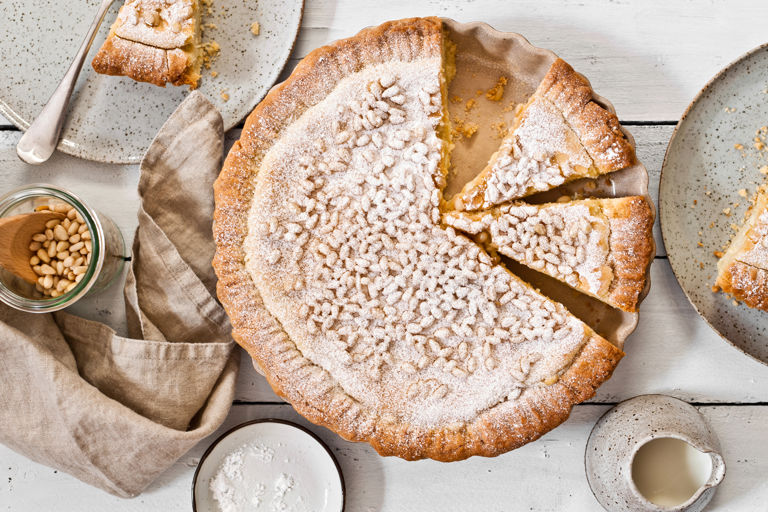Torta della nonna
This sumptuous torta della nonna recipe from Valeria Necchio offers a slice of Tuscan indulgence, with a sweet pastry base giving way to lemon- and vanilla-scented custard filling. Topped off with a thin layer of pastry and crunchy pine nuts, this tart is a real treat.
A classic, Tuscan-born tart, Torta della Nonna has to be one of the most widespread and well-known Italian desserts. Its success likely lies in its simplicity: it consists of nothing more than two sheets of slightly leavened sugar pastry enclosing a creamy heart of lemon-scented custard. The top is studded with crunchy pine nuts and dusted with icing sugar, and no variants on this theme have ever gained much momentum.
Although the name might suggest otherwise, Torta della Nonna (Grandma's cake) isn’t a homestead creation; it wasn’t, in other words, invented by some pastry-savvy grandmother somewhere in the hills of Chianti. Rather, it appears to come from the kitchen of a restaurant. The origin is actually contentious, and is still reason for much debate between the provinces of Arezzo and Florence, each claiming this tart as their own brainchild.
The most accredited version states that it was a Florentine chef who first coded it – Guido Samorini of restaurant San Lorenzo. Rumour has it that he put the tart on the menu to jazz up the slightly monotone dessert list, and that the tart became an instant hit, so much so that it was never taken off the menu ever since.
Be that as it may, the combination of pastry, custard and pine nuts seems to have been around since much before Samorini; at least since the late 1800s, as Artusi mentions he tasted such pasticcio (hash) in one of his travels across the peninsula.
And it is precisely by Artusi that my recipe for Torta della Nonna is inspired. The pastry is a slight riff on one of his three pasta frolla (sugar pastry) recipes, (with the only difference of a pinch of leavening added to the dough). As for the custard, Artusi scents his solely with vanilla, while a classic Torta della Nonna filling has a bit of lemon zest thrown in there, too, so I worked it in his crema pasticcera recipe. And finally, a trick to prevent the pine nuts from burning is to rinse them thoroughly in cold water: they’ll come out of the oven perfectly golden, and just on the right side of toasted.
Ingredients
Metric
Imperial
Pastry
- 300g of 00 flour
- 1 tsp baking powder
- 130g of caster sugar
- 150g of unsalted butter, cold, cut into small cubes (plus extra for greasing the tin)
- 1 large egg, plus 1 egg yolk, lightly whisked
- 1 unwaxed lemon, zested
Custard filling
- 5 large egg yolks
- 100g of caster sugar
- 30g of 00 flour
- 600ml of whole milk
- 1 unwaxed lemon, zest peeled into thin strips
- 1/2 vanilla pod, seeds scraped
To serve
- 80g of pine nuts, rinsed in cold water
- icing sugar, for dusting
Method
Get in touch
Please sign in or register to send a comment to Great British Chefs.




